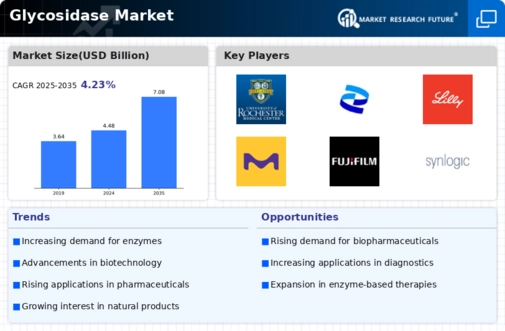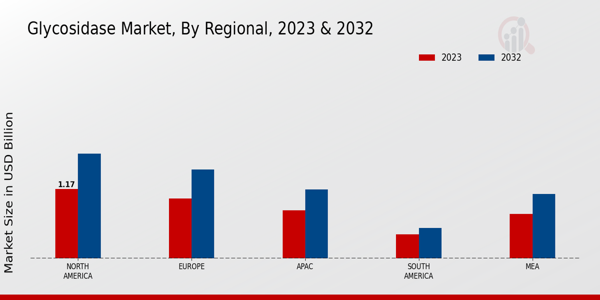Market Growth Projections
The Global Glycosidase Market Industry is projected to experience substantial growth over the coming years. With a market value anticipated to reach 4.48 USD Billion in 2024 and 7.08 USD Billion by 2035, the industry is poised for a robust expansion. The compound annual growth rate of 4.24% from 2025 to 2035 indicates a steady increase in demand for glycosidases across various applications. This growth trajectory reflects the increasing recognition of the importance of enzymes in diverse sectors, including pharmaceuticals, food processing, and biofuels, highlighting the evolving landscape of the glycosidase market.
Regulatory Support for Biocatalysts
The Global Glycosidase Market Industry benefits from increasing regulatory support for biocatalysts, which are recognized for their environmental advantages over traditional chemical processes. Governments worldwide are promoting the use of enzymes in industrial applications to reduce carbon footprints and enhance sustainability. This regulatory encouragement is evident in policies that favor green chemistry and bioprocessing technologies. As industries align with these regulations, the demand for glycosidases is likely to rise, further propelling market growth. This supportive regulatory environment is crucial for fostering innovation and adoption of glycosidases across multiple sectors.
Growing Applications in Pharmaceuticals
The pharmaceutical sector is increasingly recognizing the potential of glycosidases, thereby driving growth in the Global Glycosidase Market Industry. These enzymes play a pivotal role in drug formulation, particularly in the synthesis of glycosylated compounds, which are essential for the efficacy of many therapeutic agents. The rise in chronic diseases and the demand for targeted therapies are propelling the need for glycosidases in drug development. This trend is likely to sustain the market's expansion, with a projected compound annual growth rate of 4.24% from 2025 to 2035, indicating a robust future for glycosidase applications in pharmaceuticals.
Rising Demand for Enzyme-Based Products
The Global Glycosidase Market Industry is experiencing a surge in demand for enzyme-based products across various sectors, including pharmaceuticals, food and beverages, and biofuels. This trend is driven by the increasing consumer preference for natural and organic products, which has led to a higher utilization of glycosidases in food processing and dietary supplements. For instance, glycosidases are employed in the production of high-fructose corn syrup and in the brewing industry to enhance flavor profiles. As a result, the market is projected to reach 4.48 USD Billion in 2024, reflecting a growing inclination towards enzyme applications.
Increased Research and Development Activities
Research and development activities in enzyme technology are significantly impacting the Global Glycosidase Market Industry. Academic institutions and private companies are investing in R&D to explore new applications and improve existing glycosidases. This focus on innovation is leading to the discovery of novel enzymes with unique properties, which can be tailored for specific industrial applications. For instance, ongoing studies are examining the use of glycosidases in biocatalysis for sustainable chemical processes. As R&D continues to flourish, it is expected to enhance the market landscape, fostering new opportunities and applications in various sectors.
Technological Advancements in Enzyme Production
Technological innovations in enzyme production are significantly influencing the Global Glycosidase Market Industry. Advances in biotechnology and genetic engineering have enabled the development of more efficient and cost-effective glycosidases. For example, recombinant DNA technology allows for the production of enzymes with enhanced stability and activity, which are crucial for industrial applications. This not only improves yield but also reduces production costs, making glycosidases more accessible to various industries. As these technologies continue to evolve, they are expected to contribute to the market's growth, potentially leading to a market value of 7.08 USD Billion by 2035.

























Leave a Comment